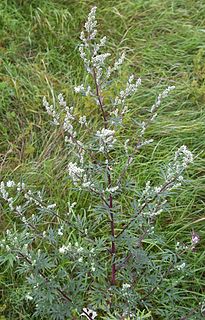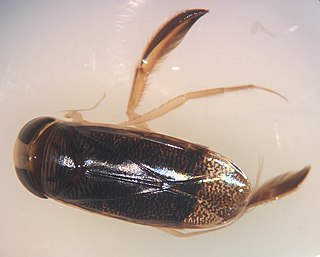
Thyme is the herb of some members of the genus Thymus of aromatic perennial evergreen herbs in the mint family Lamiaceae. Thymes are relatives of the oregano genus Origanum. They have culinary, medicinal, and ornamental uses, and the species most commonly cultivated and used for culinary purposes is Thymus vulgaris.

Senecio vulgaris, often known by the common names groundsel and old-man-in-the-spring, is a flowering plant in the daisy family Asteraceae. It is an annual herb, native to Europe and widely naturalised as a ruderal species in suitable disturbed habitats worldwide.

Phaseolus vulgaris, also known as the common bean and French bean, is a herbaceous annual plant grown worldwide for its edible dry seeds or unripe fruit. The main categories of common beans, on the basis of use, are dry beans, snap beans and shell (shelled) beans. Its leaf is also occasionally used as a vegetable and the straw as fodder. Its botanical classification, along with other Phaseolus species, is as a member of the legume family Fabaceae. Like most members of this family, common beans acquire the nitrogen they require through an association with rhizobia, which are nitrogen-fixing bacteria.

Artemisia vulgaris, the common mugwort, is a species of flowering plant in the daisy family Asteraceae. It is one of several species in the genus Artemisia commonly known as mugwort, although Artemisia vulgaris is the species most often called mugwort. It is also occasionally known as riverside wormwood, felon herb, chrysanthemum weed, wild wormwood, old Uncle Henry, sailor's tobacco, naughty man, old man or St. John's plant. Mugworts have been used medicinally and as culinary herbs.

Calluna vulgaris, common heather, ling, or simply heather, is the sole species in the genus Calluna in the flowering plant family Ericaceae. It is a low-growing evergreen shrub growing to 20 to 50 centimetres tall, or rarely to 1 metre (39 in) and taller, and is found widely in Europe and Asia Minor on acidic soils in open sunny situations and in moderate shade. It is the dominant plant in most heathland and moorland in Europe, and in some bog vegetation and acidic pine and oak woodland. It is tolerant of grazing and regenerates following occasional burning, and is often managed in nature reserves and grouse moors by sheep or cattle grazing, and also by light burning.

Primula vulgaris, the common primrose, is a species of flowering plant in the family Primulaceae, native to western and southern Europe, northwest Africa, and parts of southwest Asia. The common name is primrose, or occasionally common primrose or English primrose to distinguish it from other Primula species also called primroses. None of these are closely related to the evening primroses.

Syringa vulgaris, the lilac or common lilac, is a species of flowering plant in the olive family Oleaceae, native to the Balkan Peninsula, where it grows on rocky hills. Grown for its scented flowers in spring, this large shrub or small tree is widely cultivated and has been naturalized in parts of Europe and North America. It is not regarded as an aggressive species. It is found in the wild in widely scattered sites, usually in the vicinity of past or present human habitations.

Era Vulgaris is the fifth studio album by American rock band Queens of the Stone Age. Recorded from July 2006 to April 2007, it was released on June 11, 2007 in the United Kingdom and June 12 in the United States, having been released on June 8 in other countries. The single "Sick, Sick, Sick" was released in May, followed by second single "3's & 7's" in early June, and third single "Make It wit Chu" in October. The album debuted at No. 14 on the U.S. Billboard 200 charts, selling 52,000 copies in its first week. It reached top ten positions in other countries, such as No. 7 in the UK, No. 5 in Canada, and No. 4 in Australia. is the band's last album with Interscope Records

Sarecycline is a narrow-spectrum tetracycline-derived antibiotic. It is specifically designed for the treatment of acne, and was approved by the FDA in October 2018 for the treatment of inflammatory lesions of non-nodular moderate to severe acne vulgaris in patients 9 years of age and older. Two randomized and well-controlled clinical trials reported efficacy data on both facial and truncal acne. Efficacy was assessed in a total of 2002 subjects 9 years of age and older. Unlike other tetracycline-class antibiotics, sarecycline has a long C7 moiety that extends into and directly interact with the bacterial messenger RNA (mRNA). The spectrum of activity is limited to clinically relevant Gram-positive bacteria, mainly Cutibacterium acnes, with little or no activity against Gram-negative bacterial microflora commonly found in the human gastrointestinal tract. Sarecycline has not been tested in spirochetes.

Thanatus vulgaris is a species of running crab spider in the family Philodromidae. It is found in North America, Europe, North Africa, Turkey, Israel, Caucasus, a range from Russia, Central Asia, China, and Korea.
Systoechus vulgaris, the grasshopper bee fly, is a species of bee fly in the family Bombyliidae.
Hesperocorixa laevigata is a species of water boatman in the family Corixidae. It is found in Central America and North America.

Hesperocorixa is a genus of water boatmen in the family Corixidae. There are more than 20 described species in Hesperocorixa.

Hesperocorixa interrupta is a species of water boatman in the family Corixidae. It is found in North America.
Hesperocorixa lobata is a species of water boatman in the family Corixidae. It is found in North America.

Tomocerus vulgaris is a species of elongate-bodied springtail in the family Tomoceridae. It is found in Europe.
Hesperocorixa obliqua is a species of water boatman in the family Corixidae. It is found in North America.

Rhyparochromus vulgaris is a species of dirt-colored seed bug in the family Rhyparochromidae. It is found in Africa, Europe and Northern Asia, North America, and Southern Asia. This bug was first recorded in North America in 2001.
Hesperocorixa atopodonta is a species of water boatman in the family Corixidae. It is found in North America.













